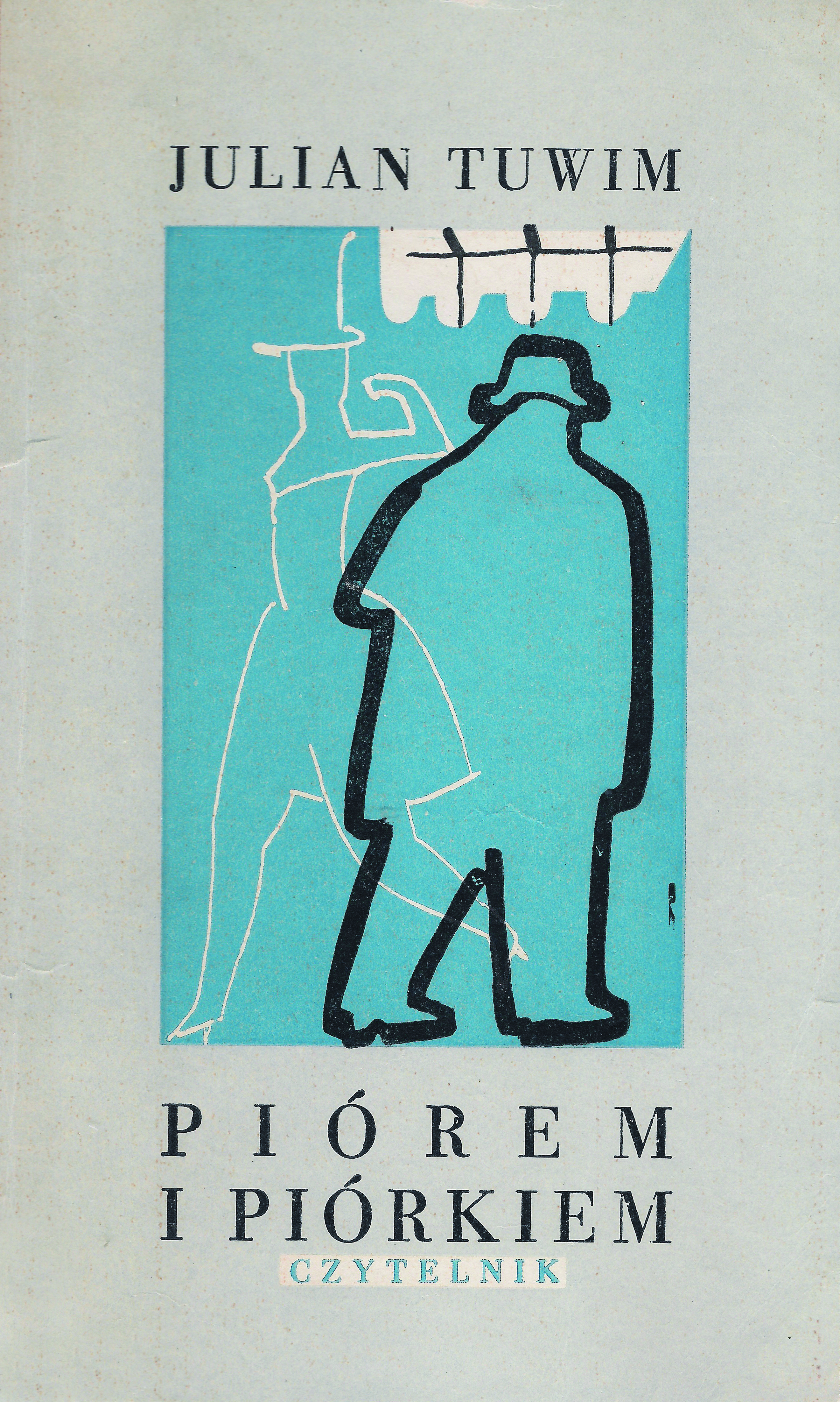Title of the work
Country of the First Edition
Country/countries of popularity
Original Language
First Edition Date
First Edition Details
Żaby łacinniczki [Frogs the Latinists],1930.
Łacina [Latin], 1938.
Genre
Didactic poetry
Instructional and educational works
Poetry
Target Audience
Crossover
Cover

Żaby łacinniczki [Frogs the Latinists], [in:] Julian Tuwim, Piórem i piórkiem [With Pen and Quill]. Courtesy of Czytelnik.
Author of the Entry:
Summary: Maria Karpińska, University of Warsaw, mariakarpinska@student.uw.edu.pl
Analysis: Karolina Anna Kulpa, University of Warsaw, k.kulpa@al.uw.edu.pl
Peer-reviewer of the Entry:
Katarzyna Marciniak, University of Warsaw, kamar@al.uw.edu.pl
Elżbieta Olechowska, University of Warsaw, elzbieta.olechowska@gmail.com

Photograph by Władysław Miernicki, retrieved from the National Digital Archives.
Julian Tuwim
, 1894 - 1953
(Author)
An eminent poet, satirist and translator; the co-founder of the literary cabaret Pikador, one of the creators and main representatives of the famous group of poets Skamander; author of lyric poetry, satirical poems, poems for children, stage adaptations, lyrics for popular songs as well as books on literary history. His poems achieved an enormous popularity among readers and became classics of modern Polish literature. He also translated such authors as Horace, Whitman, Longfellow, Rimbaud, Pushkin, Lermontov, and Gogol. Tuwim’s works for children are exceptional. Today his poems like Lokomotywa [The Locomotive], Słoń Trąbalski [Trunky Elephant], Okulary [Eyeglasses], Spóżniony Słowik [The Tardy Nightingale], Rzepka [The Little Turnip] or Abecadło [The Alphabet] belong to the canon of children’s literature. The value of his poems for children lies in the creative, melodious use of language, unusual skills in playing with words combined with original narrative concepts. On January 6, 2013 – exactly one hundred years since his literary debut in the newspaper Kurier Warszawski – the year 2013 was proclaimed by Polish authorities the Year of Julian Tuwim.
Website of the Julian Tuwim and Irena Tuwim Foundation (accessed: June 28, 2018).
Sources:
Cieślik, Tomasz and Krystyna Ratajczak, eds., Julian Tuwim. Biografia, twórczość, recepcja, Łódź: Wydawnictwo Uniwersytetu Łódzkiego, 2007.
"Julian Tuwim", in Julian Krzyżanowski, ed., Literatura polska. Przewodnik encyklopedyczny, vol. 2: N–Ż, Warszawa: Państwowe Wydawnictwo Naukowe, 1985, 506–507.
Matywiecki, Piotr, Twarz Tuwima, Warszawa: WAB, 2007.
Urbanek, Mariusz. Tuwim, Wrocław: Wydawnictwo Dolnośląskie, 2004.
Bio prepared by Maria Karpińska, University of Warsaw, mariakarpinska@student.uw.edu.pl
Translation
Latin: "Latinitas", trans. Krzysztof Tomasz Witczak [Christophorus Thomas Witczak], Živa Antika 46 (1996): 40.
Summary
Based on: Katarzyna Marciniak, Elżbieta Olechowska, Joanna Kłos, Michał Kucharski (eds.), Polish Literature for Children & Young Adults Inspired by Classical Antiquity: A Catalogue, Faculty of “Artes Liberales”, Warsaw: University of Warsaw, 2013, 444 pp.
In Żaby łacinniczki [Frogs the Latinists] the poet extends his thanks to frogs for their spirit-lifting croaking which he claims to be done in Latin. It is a twelve-verse poem based on the humorous similarity of sound between Latin words (such as quamquam or cum) and the croaking of frogs. Tuwim plays with words, skillfully rhyming in “frog Latin.”
The poem Łacina [Latin] begins with a lamentation on the fate of someone who must learn Latin. Memorizing variations of Latin grammatical forms is labelled as misery enhanced by an unlimited number of exceptions. And yet, suddenly, all the misery ends: Latin starts to circulate in the student’s veins. He is proud to understand and know so much about Antiquity. Reading in Latin becomes a new and joyful experience resulting in an appreciation for the ancient civilisation. At the end, the student recalls the laborious cramming of Latin conjugations and declensions but sees it as worthwhile because the efforts taught him to love Ancient Rome. The poet tells the story with his typical, playful eloquence, interspersing the Polish text with many Latin words.
Analysis
Julian Tuwim wrote several poems about learning Latin, for e.g. Łacina [Latin] published in 1938 and Nad Cezarem [Over Caesar] published in 1926. In both, he expresses joy that while learning Latin could be difficult, it brings important rewards helping to understand our history, mainly ancient times. So we read in the amusing poem Żaby łacinniczki that frogs’ croaking can be helpful for Latin students because in Polish the sound frogs make is identical with the Latin “cum.” In the poem Łacina we are told that annoying repetition of Latin declensions brings understanding and love for ancient Rome and Roman writers. And, finally, in Nad Cezarem the poet recalls with nostalgia the time spent in school reading Commentarii de Bello Gallico [Commentaries on the Gallic War] by Julius Caesar; he introduces in the text of the poem short well-known quotations from De bello Gallico. At the time of the publication of the three mentioned poems, Latin was a compulsory subject in Polish secondary schools.* After WW1, Poland recovered independence and started the process of unification of three different systems of administration, including education.** The system of teaching Latin in the Russian partition was presented e.g. in Wspomnienia niebieskiego mundurka [Memories of the Blue School Uniform] by Witold Gomulicki from 1906 (see the entry). In 1932 brothers Janusz and Wacław Jędrzejewicz introduced a reform of education for the new generations of young Poles. Latin became a compulsory subject during four years of gymnasium. After WW2, communist authorities began reducing teaching of Latin at school until it became optional.***
Most of the texts in the Polish literature where Latin lessons are discussed, such as Gomulicki’s school stories, Tuwim’s poems and Lekcja Łaciny [Latin Lesson] by Zbigniew Herbert from 1973 (published in Labirynt nad morzem. Warsaw: Zeszyty Literackie, 2000, pp.165–197) highlight learning Latin as something difficult, but important for knowing and understanding ancient Rome and Roman literature and also their significance for the Polish culture. A different view on Latin we see in Ferdydurke by Witold Gombrowicz (Warsaw: Towarzystwo Wydawnicze "Rój", 1938), where the author mocks Latin teachers and presents this ancient language as boring and useless.
* See Wanda Popiak, Łacina i greka w polskiej szkole w latach 1919–1939, Warszawa: Centrum Doskonalenia Nauczycieli im. Władysława Spasowskiego, 1990.
** More in: Elżbieta Olechowska, "Teaching Latin and Greek in Inter-War Poland", in David Movrin, Elżbieta Olechowska, eds., Classic and Class, Warsaw: OBTA et al., 2016, 214–228.
*** More in: Barbara Brzuska "Latin and Politics in People’s Poland", in Classic and Class…, 229–286.
Further Reading
Brzuska, Barbara, "Latin and Politics in People’s Poland", in David Movrin, Elżbieta Olechowska, eds., Classic and Class, Warsaw: OBTA et al., 2016, 229–286.
Olechowska, Elżbieta, Teaching Latin and Greek in Inter-War Poland, in David Movrin, Elżbieta Olechowska, eds., Classic and Class, Warsaw: OBTA et al., 2016, 214–228.
Popiak, Wanda, Łacina i greka w polskiej szkole w latach 1919–1939, Warszawa: Centrum Doskonalenia Nauczycieli im. Władysława Spasowskiego, 1990.
Addenda
Entry based on edition: Żaby łacinniczki [Frogs the Latinists] and Łacina [Latin], in: Julian Tuwim, Piórem i piórkiem [With Pen and Quill]. Warszawa: Czytelnik, 1957, pp. 174, 176.


